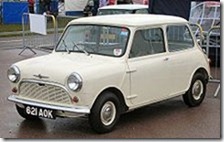This is it, the Morris Mini-Minor. At the front, a transverse 848cc engine: front wheel drive, external door hinges, sliding windows. At the back, more room that you had a right to expect, hinged re ar windows, a small boot made even smaller by the inclusion of a spare wheel, fuel tank and battery.
ar windows, a small boot made even smaller by the inclusion of a spare wheel, fuel tank and battery.
Most importantly, it had a wheel at each corner, literally at each corner, almost zero overhang. Combined with a low centre of gravity and very direct rack and pinion steering.
Along came a guy called John Cooper, famous for making winning Formula One cars at the time. He reworked the A series engine and produced the 970cc and 997cc Mini Cooper and the 1071cc and 1275cc Cooper ‘S’. This is the car which would win the Monte Carlo Rally in 1964, ‘65 and ‘67. Anybody could go to a Mini dealer and buy either of the Coopers, and more than a few did. With a bit of preparation and a Halda meter, club rallying became a reality. To stop the Coopers, they were fitted with twin caliper disc brakes at the front.
Rallying success opened the gates for every tuning company in the country to produce ‘go faster’ bits, and trust me, they did. A standard mini could become anything you wanted it to be with cash and the time to do the work.
My experience with a Mini
I bought a Mini Clubman Estate because I liked the idea of extra space. While travelling in North Wales, I encountered a hill so steep that the Mini could not make it to the top. I vowed that on my return, the Mini would not only make it all of the way up, but that it would do it with attitude to spare.
I acquired an MG Metro engine, Stage 3 ported head, 286 cam, Maniflow manifold and exhaust system, K&N filter, Cooper S brakes, finned aluminium rear brake drums to bring the rear track in-line with the front, and Hi-Lo suspension units all round.
The result was around 80bhp at the wheels, huge torque which could get the car moving in 3rd gear, a top speed just shy of 100mph, and more fun that words can put across. It was as fast through corners as it was down straights, and first gear was only used on steep hill starts.
The combination of induction roar through the K&N and the Maniflow system underneath was magical, but not on long trips down motorways. In the country, it was just incredible.
The only trouble was in towns and cities. Power came in at over 3000rpm, and if one happened to hit that in traffic, the car would surge forwards, firmly pressing the occupants back into the racing seats.
I picked up parts from auto fairs, and performance specialists like Minisport of Padiham. I would like to make a special mention about Minisprint Engine Developments (MED) of Leicester, in particular the owner, Steve Whitton, who did a great job with the engine and setup.
Problems with all Minis
Corrosion kills them all in the end. The ‘A’ panels ahead of the doors are double skinned and always go first in the panel behind. By the time that it surfaces, you have major problems. The drains around the roof line are bad, around the headlights, as are the rear doors on the Estate versions. Corrosion underneath at the back kills the rear brake pipes, sub-frame, electric fuel pumps on earlier models, and the handbrake cables and quadrants. Rear brakes are prone to seizing, and the battery boxes in the saloons have been known to fall out while in motion.
At the end of the day
Minis are priceless despite the lack of comfort, the noise and corrosion issues. You can’t have more fun for the money, and the shape is as timeless as ever it was. If ever you get the chance, drive one. I guarantee that you will want one after the experience.
For more reading, look here.. http://en.wikipedia.org/wiki/Mini

